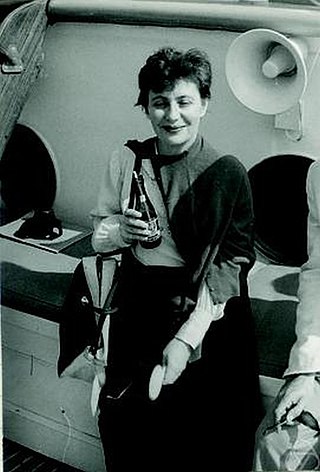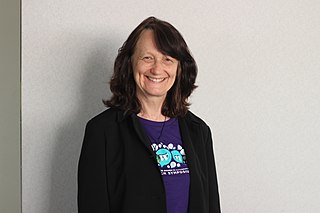Related Research Articles

Dame Mary Lucy Cartwright was a British mathematician. She was one of the pioneers of what would later become known as chaos theory. Along with J. E. Littlewood, Cartwright saw many solutions to a problem which would later be seen as an example of the butterfly effect.

Yakov Grigorevich Sinai is a Russian–American mathematician known for his work on dynamical systems. He contributed to the modern metric theory of dynamical systems and connected the world of deterministic (dynamical) systems with the world of probabilistic (stochastic) systems. He has also worked on mathematical physics and probability theory. His efforts have provided the groundwork for advances in the physical sciences.
Susan Mary Rees, FRS is a British mathematician and an emeritus professor of mathematics at the University of Liverpool since 2018, specialising in research in complex dynamical systems.
Rostislav Ivanovich Grigorchuk is a mathematician working in different areas of mathematics including group theory, dynamical systems, geometry and computer science. He holds the rank of Distinguished Professor in the Mathematics Department of Texas A&M University. Grigorchuk is particularly well known for having constructed, in a 1984 paper, the first example of a finitely generated group of intermediate growth, thus answering an important problem posed by John Milnor in 1968. This group is now known as the Grigorchuk group and it is one of the important objects studied in geometric group theory, particularly in the study of branch groups, automaton groups and iterated monodromy groups. Grigorchuk is one of the pioneers of asymptotic group theory as well as of the theory of dynamically defined groups. He introduced the notion of branch groups and developed the foundations of the related theory. Grigorchuk, together with his collaborators and students, initiated the theory of groups generated by finite Mealy type automata, interpreted them as groups of fractal type, developed the theory of groups acting on rooted trees, and found numerous applications of these groups in various fields of mathematics including functional analysis, topology, spectral graph theory, dynamical systems and ergodic theory.

Gustav Arnold Hedlund, an American mathematician, was one of the founders of symbolic and topological dynamics.

Mikhail (Misha) Lyubich is a mathematician who has made important contributions to the fields of holomorphic dynamics and chaos theory.
Amie Wilkinson is an American mathematician and Professor of Mathematics at the University of Chicago. Her research topics include smooth dynamical systems, ergodic theory, chaos theory, and semisimple Lie groups. Wilkinson, in collaboration with Christian Bonatti and Sylvain Crovisier, partially resolved the twelfth problem on Stephen Smale's list of mathematical problems for the 21st Century.
Bryna Rebekah Kra is an American mathematician and Sarah Rebecca Roland Professor at Northwestern University who is on the board of trustees of the American Mathematical Society and was elected the president of the American Mathematical Society in 2021. As a member of the American Academy of Arts and Sciences and the National Academy of Sciences, Kra has made significant contributions to the structure theory of characteristic factors for multiple ergodic averages. Her academic work centered on dynamical systems and ergodic theory, and uses dynamical methods to address problems in number theory and combinatorics.

Hee Oh is a South Korean mathematician who works in dynamical systems. She has made contributions to dynamics and its connections to number theory. She is a student of homogeneous dynamics and has worked extensively on counting and equidistribution for Apollonian circle packings, Sierpinski carpets and Schottky dances. She is currently the Abraham Robinson Professor of Mathematics at Yale University.

Caroline Mary Series is an English mathematician known for her work in hyperbolic geometry, Kleinian groups and dynamical systems.

Fern Yvette Hunt is an American mathematician known for her work in applied mathematics and mathematical biology. She currently works as a researcher at the National Institute of Standards and Technology, where she conducts research on the ergodic theory of dynamical systems.
Idris Assani is a Beninese mathematician, who works as a professor of mathematics at the University of North Carolina at Chapel Hill.
Laura Grace DeMarco is a professor of mathematics at Harvard University, whose research concerns dynamical systems and complex analysis.

Robert Luke Devaney is an American mathematician. He is the Feld Family Professor of Teaching Excellence at Boston University, and served as the president of the Mathematical Association of America from 2013 to 2015. His research involves dynamical systems and fractals.

Yael Naim Dowker was an Israeli-born english mathematician, prominent especially due to her work in the fields of measure theory, ergodic theory and topological dynamics.

Ami Elizabeth Radunskaya is an American mathematician and musician. She is a professor of mathematics at Pomona College, where she specializes in dynamical systems and the applications of mathematics to medicine, such as the use of cellular automata to model drug delivery. In 2016 she was elected as the president of the Association for Women in Mathematics (AWM).

Yakov Borisovich Pesin was born in Moscow, Russia on December 12, 1946. Pesin is currently a Distinguished Professor in the Department of Mathematics and the Director of the Anatole Katok Center for Dynamical Systems and Geometry at the Pennsylvania State University (PSU). His primary areas of research are the theory of dynamical systems with an emphasis on smooth ergodic theory, dimension theory in dynamical systems, and Riemannian geometry, as well as mathematical and statistical physics.
Brian Marcus is an American-born mathematician who works in Canada. He is a professor in the department of mathematics at the University of British Columbia (UBC), where he is the site director of the Pacific Institute for the Mathematical Sciences (PIMS), a fellow of the AMS and the IEEE. He was the department head of mathematics at UBC from 2002 to 2007 and the deputy director of PIMS from 2016 to 2018.
Karma Dajani is a Lebanese-Dutch mathematician whose research interests include ergodic theory, probability theory, and their applications in number theory. She is an associate professor of mathematics at Utrecht University.

Daniel Jay Rudolph (1949–2010) was a mathematician who was considered a leader in ergodic theory and dynamical systems. He studied at Caltech and Stanford and taught postgraduate mathematics at Stanford University, the University of Maryland and Colorado State University, being appointed to the Albert C. Yates Endowed Chair in Mathematics at Colorado State in 2005. He jointly developed a theory of restricted orbit equivalence which unified several other theories. He founded and directed an intense preparation course for graduate math studies and began a Math circle for middle-school children. Early in life he was a modern dancer. He died in 2010 from amyotrophic lateral sclerosis, a degenerative motor neuron disease.
References
- 1 2 3 Jane M. Hawkins; J. Hawkins, How I became a mathematician.
- ↑ J. Hawkins and D. Molinek, Markov cellular automata models for chronic disease progression, International Journal of Biomathematics, 8 (2015).
- ↑ Jane Hawkins at the Mathematics Genealogy Project; J. Hawkins, Dynamics of mathematical groups, in I, Mathematician, ed. P. Casazza, S.G. Krantz and R.D. Ruden (Mathematical Association of America, 2015), 192-202.
- ↑ Brief vita (PDF), US Congress, 2012; Hawkins, Jane M., Dynamics of mathematical groups (PDF)
- ↑ Hawkins, Jane (28 January 2021). Ergodic Dynamics: From Basic Theory to Applications. Springer. ISBN 9783030592424.
- ↑ Hawkins, Jane (23 Mar 2024). The Mathematics of Cellular Automata. American Mathematical Society. ISBN 9781470475376.
- ↑ Hawkins Testimony 3/22/12
- ↑ Hawkins presents testimony, Notices of the American Mathematical Society 51 (2004), 668.
- ↑ "Past Officers and Executive Directors".
- ↑ "AMS Committees". American Mathematical Society. Retrieved 2023-03-27.
- ↑ George Washington University SPWM
- ↑ Holy Cross Milestones
- ↑ List of Fellows of the American Mathematical Society